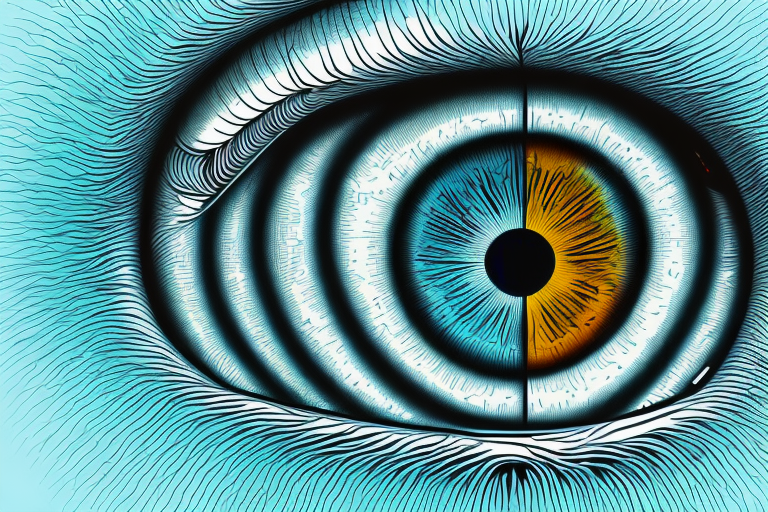The human eye is a remarkable organ that allows us to perceive the world around us. Understanding its anatomy is key to understanding various eye conditions, including cataracts, and their impact on vision.
Understanding the Eye’s Anatomy
The eye is a complex structure composed of various parts that work together to create vision. Every component has a crucial role in this process.
Let’s delve deeper into the fascinating world of the eye’s anatomy and explore the intricate details of its different parts.

The Cornea and Its Role in Vision
One of the primary components of the eye is the cornea, a transparent outer layer that covers the iris and pupil. Its smooth surface helps focus light onto the lens, allowing for better visual clarity.
But did you know that the cornea is not just a simple layer of tissue? It is actually a highly organized structure consisting of five distinct layers, each with its own unique function.
The outermost layer, called the epithelium, acts as a protective barrier against dust, debris, and harmful microorganisms. Beneath it lies the Bowman’s layer, which provides strength and stability to the cornea.
Next, we have the stroma, which makes up the majority of the cornea’s thickness. It is composed of collagen fibers arranged in a precise pattern, giving the cornea its transparency.
The Descemet’s membrane, located beneath the stroma, acts as a barrier against fluid leakage and helps maintain the cornea’s shape. Finally, the innermost layer, called the endothelium, pumps out excess fluid to keep the cornea clear and healthy.
However, the cornea’s health can be compromised by factors such as injury or disease, leading to vision problems. Conditions like keratitis, corneal dystrophy, or corneal ulcers can cause pain, redness, and blurred vision. Also find more about Recovery Time and Process After Cataracts Surgery by visiting https://occounselingforwomen.com/recovery-time-and-process-after-cataracts-surgery/
The Lens: A Crucial Component for Sight
The lens is another critical part of the eye that helps focus light onto the retina. Its flexibility allows us to adjust our focus for objects at different distances.
But let’s not forget that the lens is not a static structure. It undergoes continuous changes throughout our lifetime, gradually losing its flexibility and clarity.
As we age, the lens can become cloudy, leading to a condition known as cataracts. Cataracts can affect the clarity of the lens, causing blurry vision and difficulty seeing clearly. Know more about Most Frequently Asked Questions and Answers on Cataract Surgery by clicking here.
Fortunately, cataract surgery is a common and highly successful procedure that involves removing the cloudy lens and replacing it with an artificial one. This restores clear vision and allows individuals to enjoy a better quality of life.
The Retina: Converting Light into Images
The retina, located at the back of the eye, plays a vital role in converting light into electrical signals that the brain can interpret as images. It contains specialized cells called rods and cones that are responsible for capturing light and transmitting visual information.
But let’s take a closer look at these remarkable cells. Rods, which are more numerous than cones, are responsible for vision in low-light conditions. They are highly sensitive to light and help us see in dimly lit environments.
Cones, on the other hand, are responsible for color vision and visual acuity. They are concentrated in the central part of the retina, known as the macula, which is responsible for our sharp and detailed vision.
When cataracts develop, they can interfere with the retina’s ability to receive clear and accurate visual information. This can result in a decrease in visual acuity, contrast sensitivity, and color perception.
Understanding the intricate anatomy of the eye and how its different components work together is essential for appreciating the complexity of our visual system. It reminds us of the delicate balance that exists within our eyes and the importance of taking care of them.
What are Cataracts?
Cataracts are characterized by the clouding of the eye’s natural lens, leading to decreased vision quality. They are a common age-related condition, although other factors like genetics, trauma, and certain medications can also contribute to their development.
When it comes to understanding cataracts, it is important to delve into their development, the different types that exist, and the common symptoms that individuals may experience.
The Development of Cataracts
Cataracts typically develop gradually over time, often starting with small changes in vision. The clouding of the lens occurs when proteins in the eye clump together, forming a cloudy area. As the cataract progresses, it can cause significant vision impairment if left untreated.
It is important to note that cataracts do not spread from one eye to the other, but they can develop independently in both eyes.
Different Types of Cataracts
There are different types of cataracts, each affecting a specific area of the lens and potentially having slightly different symptoms and progression.
1. Nuclear Sclerotic Cataracts: This type of cataract forms in the center of the lens and is the most common type associated with aging. As the lens hardens and becomes yellow, it can lead to blurred vision and difficulty seeing in low light conditions.
2. Cortical Cataracts: Cortical cataracts develop in the lens cortex, which is the outer edge of the lens. These cataracts often appear as white, wedge-like opacities that extend from the periphery towards the center. They can cause difficulties with contrast sensitivity and may lead to glare and halos around lights.
3. Subcapsular Cataracts: Subcapsular cataracts form at the back of the lens, just beneath the lens capsule. They tend to progress more rapidly and can cause significant vision problems, especially in bright light conditions. Individuals with diabetes or those taking high doses of steroids are more prone to developing this type of cataract.
Common Symptoms of Cataracts
When cataracts develop, individuals may experience a range of symptoms that can impact their daily lives:
1. Blurred Vision: Cataracts can cause vision to become hazy or blurry, making it difficult to see fine details.
2. Increased Sensitivity to Light: Many people with cataracts find that bright lights, such as sunlight or headlights, cause discomfort or glare.
3. Difficulty Seeing at Night: Cataracts can make it challenging to see clearly in low-light conditions, leading to difficulties with night driving or navigating dimly lit areas.
4. Perception of Faded Colors: Colors may appear less vibrant or faded to individuals with cataracts, impacting their ability to appreciate the full spectrum of hues.
If you notice any of these symptoms, it’s essential to consult an eye care professional for a comprehensive evaluation. They can assess your vision, diagnose cataracts, and discuss treatment options tailored to your specific needs.
The Impact of Cataracts on Vision
Cataracts can have a significant impact on vision, affecting both visual acuity and perception of colors and contrast.
How Cataracts Affect Visual Acuity
As cataracts progress, they can cause increasing levels of visual impairment, making it difficult to read, drive, or perform daily tasks that require clear vision.
Often, people with cataracts experience blurred or hazy vision, as if looking through a fogged-up window.
This loss of visual acuity can be frustrating and may lead to a decrease in overall quality of life. Simple tasks like reading a book or recognizing faces can become challenging and frustrating.
Furthermore, the impact of cataracts on visual acuity can vary from person to person. Some individuals may experience mild impairment, while others may have severe vision loss.
The Influence of Cataracts on Color Perception
Cataracts can also affect the perception of colors. Colors may appear faded or dull, making it challenging to distinguish between different shades.
What was once a vibrant world of colors may become less vibrant as cataracts progress.
This loss of color perception can be particularly noticeable in activities such as appreciating art, enjoying nature, or even selecting matching clothes.
It is important to note that while cataracts can affect color perception, they do not cause complete color blindness. However, the overall richness and vibrancy of colors can be significantly diminished.
Night Vision and Cataracts
Individuals with cataracts often experience difficulty seeing in low-light environments, such as during nighttime or in dimly lit surroundings.
The clouding of the lens can reduce the amount of light that reaches the retina, resulting in poor night vision.
This can make activities like driving at night or navigating in dark areas challenging and potentially dangerous.
Additionally, cataracts can cause increased sensitivity to glare from headlights or streetlights, further impacting night vision.
It is crucial for individuals with cataracts to take extra precautions when driving or moving around in low-light conditions to ensure their safety and the safety of others.
Overall, cataracts not only affect visual acuity and color perception but also have a significant impact on night vision, making it essential for individuals to seek appropriate treatment and management options.
Treatment Options for Cataracts
Fortunately, there are effective treatment options available for cataracts, ranging from non-surgical approaches to surgical procedures.
Cataracts, a common age-related eye condition, occur when the natural lens of the eye becomes cloudy, causing blurred vision and difficulty seeing clearly. While cataracts cannot be prevented, there are various treatment options that can help restore vision and improve quality of life.
Non-Surgical Treatments for Cataracts
In the early stages of cataracts, symptoms can sometimes be managed with non-surgical interventions. These may include the use of prescription eyeglasses, magnification aids, and improved lighting.
Prescription eyeglasses can correct refractive errors and improve visual acuity, making it easier to see through the cloudy lens. Magnification aids, such as reading glasses or handheld magnifiers, can assist with reading and other close-up tasks. Additionally, optimizing lighting conditions by using brighter lights or task-specific lighting can help enhance visibility and reduce glare.
Surgical Procedures for Cataract Removal
When cataracts significantly impact an individual’s quality of life and ability to perform daily activities, surgery may be recommended. Cataract surgery involves the removal of the cloudy lens and replacement with an artificial intraocular lens.
Advancements in surgical techniques, such as phacoemulsification, have made cataract surgery safe and highly successful, with most patients experiencing improved vision post-surgery. During the procedure, a small incision is made in the cornea, and an ultrasonic probe is used to break up the cloudy lens into tiny fragments, which are then gently suctioned out. The artificial intraocular lens is then inserted, restoring clear vision.
Cataract surgery is typically performed on an outpatient basis, and patients can usually return home the same day. The recovery period is relatively short, with most individuals experiencing improved vision within a few days to weeks after surgery.
Post-Surgery Care and Vision Improvement
Following cataract surgery, post-operative care is crucial for optimal recovery and vision improvement. This may include the use of prescribed eye drops, avoiding activities that strain the eyes, and attending follow-up appointments with the eye surgeon.
Eye drops are often prescribed to prevent infection, reduce inflammation, and promote healing. It is important to follow the recommended dosage and frequency as instructed by the eye surgeon. Additionally, avoiding activities that put strain on the eyes, such as heavy lifting or rubbing the eyes, can help prevent complications and promote healing.
Regular follow-up appointments with the eye surgeon are essential to monitor the healing process and ensure that the artificial lens is properly positioned. During these appointments, vision tests may be conducted to assess visual acuity and determine if any additional treatments or adjustments are necessary.
With proper care and adequate time for healing, many individuals achieve significant vision improvement after cataract surgery. The removal of cataracts not only restores clear vision but also enhances overall quality of life, allowing individuals to engage in daily activities with ease and clarity.
Conclusion
Understanding the anatomy of the eye and the impact of cataracts on vision is essential for recognizing the signs and seeking appropriate treatment. Whether through non-surgical interventions or cataract surgery, advancements in eye care have made it possible to restore clear vision and enhance quality of life for individuals affected by cataracts.
If you or someone you know is experiencing vision problems related to cataracts, it’s crucial to consult with an eye care professional to explore the available treatment options and take proactive steps towards better vision health.



